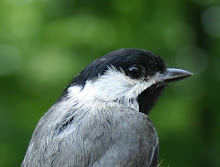Historically speaking, the Native Americans burned the prairies and woodlands on a regular basis as a way to fireproof their villages, prepare planting sites, control undesirable pests, control movement of game (especially bison), encourage berry production and expose acorns for food collection. This tradition was continued by European Settlers but US gov agencies such as the Forest Service began to discourage the practice in the early 20th century and by the 1950s the custom was extinguished.
The Ecology Center take these burns very seriously and employ a number of safety measures to ensure the success of the fire. All burns are conducted within a "prescription": a set of guidelines for weather and fire safety, taking into account factors such as humidity, temperature, wind speed, and wind direction. The Fire Department is on hand and the Ecology staff and volunteers don water tanks, rakes and flappers to control small fires that may try to burn too close to the predetermined fire breaks. (areas that serve as buffer zones between the burn site and those locations that must not be burned, such as the woodland and nearby homes). A 65 gallon water container follows the Fire Starters in the event the burn gets out of control.


The fire is started with a drip torch, an aluminum canister that holds a 2:1 fuel mixture of diesel and gasoline. The torch slowly drips fire once lit and has 2 safety mechanisms to prevent flashback.

The fire starters wear fire resistant suits made of Nomex or other similar material.

It was a beautiful day for a prairie burn. The sky was clear and there was a gentle breeze. The ground may have been a bit damp from the October rains, but there was enough dried vegetation on the ground to get the fire going.

The grasses (Big Bluestem, Indian Grass, Switchgrass) caught fire quickly and produced the exciting towers of flames but the Cup Plant and Goldenrod plant species appeared to have retained moisture from all the rain and did not easily burn. Ecology Center staff later told me these plant species normally do not burn well.

The tall plants in the middle are Cup Plants.


Fires play an important role in the Prairie ecosystem. Fire cleans and fertilizes. Most prairie plants grow from just below the surface, not from their stems above the ground so a fire will not kill these plants. However burning will clear out those unwanted plant species not adapted for a fire, plants that may have been prohibiting prairie plants from growing on their native grounds. After the growing season, prairie plants store minerals in their stems, leaves and bark. When these plants are burned and reduced to ash, the minerals in the ashes of the plants return to the soil.

The burned, blackened soil is quickly heated up by the sun's rays and stimulates seed germination, sprouting and growth.

Here is a photo of Nestbox #5, taken last summer

And here is Nestbox #5 after the burn

The burn took a little over an hour to complete and the plot will be carefully monitored for the next few days for signs of smoldering flames. In a few months there will be no sign that this burn ever took place.
Let the growing season begin!

No comments:
Post a Comment